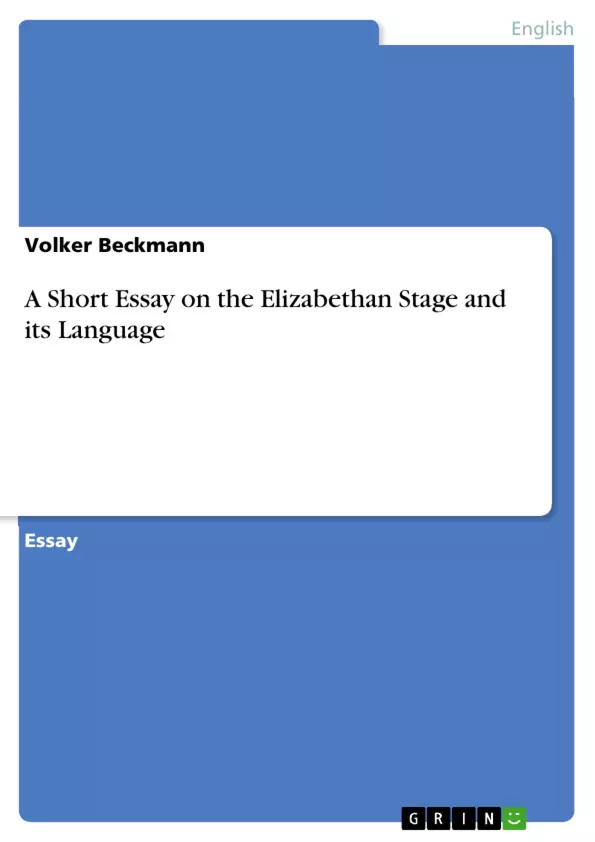The Elizabethan drama owed its development to two influential traditions: namely firstly to humanism as it was represented by the comedies written by Terence and Plautus and secondly to the English tradition of the English miracle and morality plays.
From the Latin comedies the Elizabethan drama adopted both formal innovations and new material as regards contents. To the newly adopted dramatic elements belonged the clear division into acts and scenes, the introduction of the actors who are to speak a prologue or an epilogue and new types of characters like the parasite, the miles gloriosus (the boastful knight), the shrewd and witty servant, the obstinate father who is deceived in the end, the ardent lover, and the girl disguised as a man.
As regards contents new motifs and themes like confusion, secret love affairs, separated families that happily reunite after having experienced many adventurous encounters, the unexpected reappearance of children who were believed to be lost were adopted from the plays written by Plautus.
Table of Contents
- Some Introductory Remarks about the Dramatic Traditions of the Elizabethan Stage
- Part One
- The Control of the Stage
- The Playhouses
- Boy Companies and Adult Companies
- Part Two
- The Functions of Dramatic Art: some Shakespearean Suggestions
- Three Methods of trying to Find out how Actors might have behaved on an Elizabethan Stage
- Soliloquies in Shakespeare’s Dramatic Language
- Final Observation: The Audiences
Objectives and Key Themes
This essay offers an overview of the Elizabethan stage and its language, analyzing the development of the dramatic tradition, exploring the structure and control of the stage, examining acting companies and their dynamics, and delving into the language and stylistic devices employed by Shakespeare.
- The evolution of dramatic traditions and their influence on the Elizabethan stage
- The structure and control of the stage, including the role of monarchs and officials
- The different types of playhouses, their architectural features, and the audiences they attracted
- The functioning of acting companies, their financial structures, and the use of boy companies
- The characteristics of Shakespeare's dramatic language, including new words, metaphors, and stylistic devices
Chapter Summaries
- Some Introductory Remarks about the Dramatic Traditions of the Elizabethan Stage: This chapter examines the two key traditions that influenced Elizabethan drama: Roman comedies and English mystery and morality plays. It explores the specific aspects borrowed from each, including structural elements, character types, and thematic motifs.
- The Control of the Stage: This chapter outlines the various authorities involved in the regulation of the stage and plays, including monarchs, Lord Chamberlain, and Master of the Revels. It discusses the role of censorship and the protection granted to specific acting companies.
- The Playhouses: This chapter explores the evolution of the playhouse from the medieval stage to the Elizabethan era. It covers different types of playhouses, including booth stages, baiting houses, inns, and public and private theatres. The chapter also details the architectural features of these venues, particularly the Globe and Blackfriars theatres.
- Boy Companies and Adult Companies: This chapter examines the history of acting companies, including their formation, dissolution, and financial structure. It highlights the role of boy companies and their importance in performing children's and women's roles.
- The Functions of Dramatic Art: some Shakespearean Suggestions: This chapter delves into Shakespeare's commentary on the purpose of dramatic art, using characters and scenes from various plays to explore the functions of comedy, tragedy, and the use of stylistic devices.
- Three Methods of trying to Find out how Actors might have behaved on an Elizabethan Stage: This chapter explores different methods to analyze the acting techniques employed in Elizabethan plays, including printed and implicit stage directions and spatial relationships between actors on stage.
- Soliloquies in Shakespeare’s Dramatic Language: This chapter focuses on the use of soliloquies as a dramatic device in Shakespeare's plays, particularly in his tragedies. It examines the function of this device and its evolution throughout Shakespeare's career.
Keywords
The key keywords and focus topics of this essay include: Elizabethan drama, theatre, stage, playhouses, acting companies, Shakespeare, dramatic language, soliloquies, metaphors, stylistic devices, audiences.
- Quote paper
- Dr. phil. Volker Beckmann (Author), 1983, A Short Essay on the Elizabethan Stage and its Language, Munich, GRIN Verlag, https://www.grin.com/document/456291




